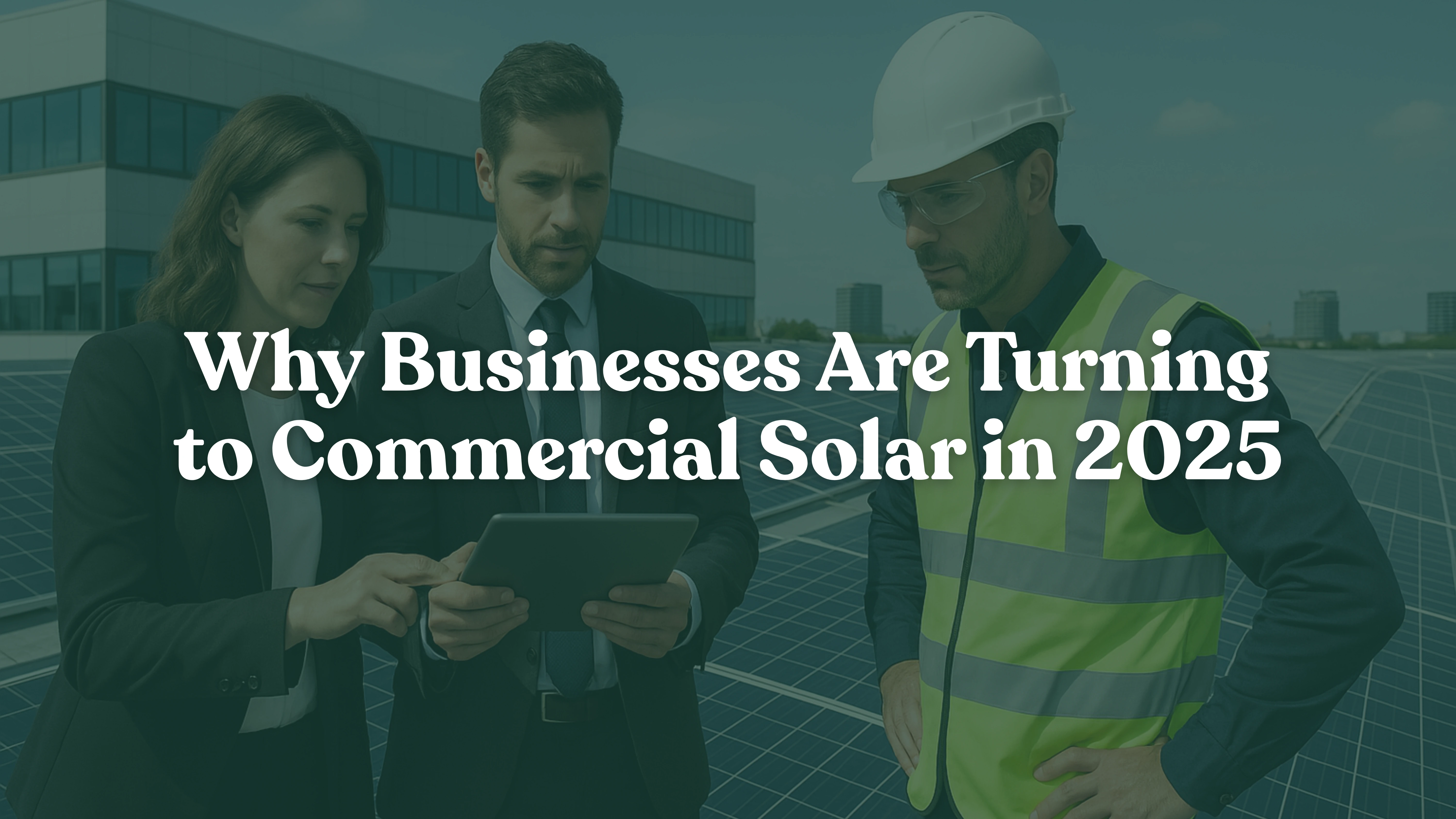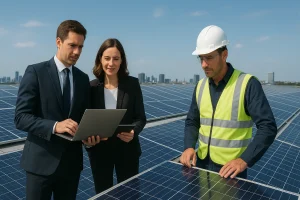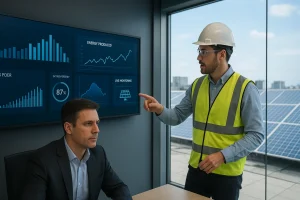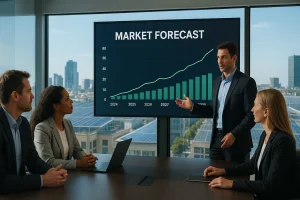Why Businesses Choose Commercial Solar in 2025

Why Businesses Are Turning to Commercial Solar in 2025
Rising electricity costs, unpredictable energy rates, and increasing pressure to meet sustainability goals are forcing businesses nationwide to seek alternatives to traditional grid power. With commercial electricity prices increasing faster than inflation and grid instability becoming more common, companies need reliable, cost-effective solutions. Commercial solar installations offer businesses immediate cost savings, energy independence, substantial tax benefits, and a competitive advantage in today’s sustainability-focused market—making 2025 the optimal year for business solar adoption.
Record-Breaking Commercial Solar Growth Drives Business Adoption
The commercial solar market achieved its strongest first quarter in history during Q1 2025, installing nearly 500 MW of capacity. Commercial solar grew by 4%, installing 486 MWdc, making it the only solar segment to increase compared to Q1 2024. This remarkable growth demonstrates that businesses across America are recognizing solar energy as a strategic investment rather than just an environmental initiative.

Smart business owners understand that commercial solar installation provides immediate operational benefits. With an average ROI of 13.52%, Solar energy consistently outperforms traditional investments, such as stocks on the S&P 500. This performance has caught the attention of solar installers and EPCs who are witnessing unprecedented demand for business solar solutions.
Commercial Solar System Costs Continue Dropping
One of the primary reasons why businesses choose commercial solar in 2025 is the continued reduction in system costs. Commercial PV system prices fell 2% annually to $1.47/Wdc, making solar installations more accessible to businesses of all sizes. This cost reduction, combined with advanced financing options, allows companies to implement solar energy systems without significant upfront capital investment.
For solar installers and EPCs, these falling costs create opportunities to serve a broader market while maintaining healthy profit margins. The trend toward higher-efficiency panels means businesses get more power generation per square foot, reducing installation complexity and maximizing system performance.
Federal Tax Benefits Make Business Solar Investment Irresistible
The federal Investment Tax Credit (ITC) remains the cornerstone of commercial solar incentives in 2025. Currently, businesses can claim a 30% tax credit for solar systems installed through 2032. This dollar-for-dollar tax reduction provides an immediate 30% discount on the entire solar investment, dramatically improving payback periods.
Beyond the ITC, businesses benefit from accelerated depreciation through the Modified Accelerated Cost Recovery System (MACRS). Bonus depreciation allows businesses to deduct 80% of the depreciable basis in the first year for systems placed in service during 2025. These combined federal incentives can reduce the effective cost of commercial solar systems by up to 60%, making solar installations financially attractive for virtually any business.
Business Solar ROI Delivers Exceptional Returns
Commercial solar systems consistently deliver impressive financial returns for business owners. Analysis of over 160 agricultural and commercial solar installations shows businesses typically achieve payback periods of 5-8 years with ROI ranging from 10-15%. Solar reduces expenses: Solar lowers electricity costs and protects against rising energy rates, making it a cost-saving mechanism.

For solar installers and EPCs, these strong financial returns make it easier to close sales and build long-term customer relationships. When businesses see immediate utility bill reductions and substantial tax benefits, they become advocates for solar energy within their industry networks.
Energy Independence Protects Against Rising Utility Rates
Smart business leaders recognize that commercial solar provides protection against unpredictable electricity rate increases. Investor-owned utility companies have increased their transmission and distribution (T&D) spending by 300% since 2005, passing these costs onto ratepayers. Solar installations shield businesses from these escalating costs while providing predictable energy expenses for 25+ years.
This energy independence particularly appeals to manufacturers, warehouses, and agricultural operations with high electricity consumption. Solar installers and EPCs can position business solar systems as long-term operational cost control measures rather than simply environmental initiatives.
Corporate Sustainability Goals Drive Commercial Solar Demand
Modern businesses face increasing pressure from customers, investors, and employees to demonstrate environmental responsibility. Corporate solar adoption has surged thanks to the Inflation Reduction Act (IRA), which offers up to 40% tax incentives for commercial solar projects. Companies like Costco, Google, and Target continue making substantial solar investments, setting examples for other businesses to follow.
For solar installers and EPCs, this trend creates opportunities beyond simple cost savings discussions. Businesses increasingly view solar installations as essential components of their corporate social responsibility strategies, making the sales process more straightforward.
Technology Advancements Improve Commercial Solar Performance
The solar industry continues delivering technological improvements that benefit commercial installations. Most new projects now use Tunnel Oxide Passivated Contact (TOPcon) modules, which offer higher efficiency. These efficiency gains allow businesses to generate more electricity from smaller roof spaces, making solar viable for facilities with limited installation areas.

Advanced monitoring systems and smart inverters provide businesses with real-time visibility into their energy production and consumption patterns. This data helps facility managers optimize energy usage while providing solar installers and EPCs with valuable performance information for system maintenance and future expansion opportunities.
Multiple Financing Options Make Commercial Solar Accessible
Businesses can choose from various financing structures to implement solar energy systems without depleting working capital. Cash purchases provide the highest long-term returns, while solar loans allow companies to spread costs over several years while still capturing tax benefits. Power Purchase Agreements (PPAs) enable businesses to adopt solar with zero upfront costs by purchasing electricity at fixed rates below utility prices.
Solar installers and EPCs benefit from this financing flexibility by serving customers with different financial preferences and capabilities. Whether working with cash-rich corporations or startups conserving capital, appropriate financing options exist for virtually every commercial solar prospect.
State and Local Incentives Enhance Federal Benefits
While federal incentives provide the foundation for commercial solar savings, state and local programs significantly enhance investment returns. Many states offer additional tax credits ranging from 5-25%, property tax exemptions, and performance-based incentives. These programs vary by location but often combine with federal benefits to create compelling financial propositions.
Solar installers and EPCs should maintain current knowledge of local incentive programs to maximize customer benefits. Understanding the full spectrum of available incentives positions professionals as valuable consultants rather than simple equipment vendors.
Market Outlook Indicates Continued Growth
Industry projections show sustained growth in commercial solar adoption throughout 2025 and beyond. Our updated forecasts for the current policy status quo show the U.S. solar industry will install 40.5 GWdc in 2024, followed by average annual volumes of at least 43 GWdc from 2025-2029. This sustained growth provides solar installers and EPCs with confidence in long-term market opportunities.

The combination of falling costs, improving technology, generous incentives, and increasing corporate sustainability focus creates ideal conditions for commercial solar market expansion. Businesses that act decisively in 2025 position themselves for decades of reduced operating costs while contributing to America’s clean energy transition.
Streamline Your Commercial Solar Success with Expert Partners
The commercial solar market in 2025 offers exceptional opportunities for businesses seeking energy independence and cost savings. However, navigating complex permitting, engineering requirements, and project management can overwhelm even experienced solar professionals.
Energyscape Renewables solves these challenges as a licensed nationwide solar engineering firm, providing end-to-end solutions from design and engineering to seamless permitting for commercial and utility-scale projects. Their integrated approach maximizes impact while minimizing costs for solar installers and EPCs.
For project management efficiency, Sunscape Solar’s specialized CRM and project management software streamlines workflows, manages client relationships, and coordinates team efforts throughout the entire solar installation process.
2025 represents the optimal time for businesses to adopt commercial solar—and the solar professionals who leverage expert engineering partnerships and advanced project management tools will capture the greatest share of this growing market.

sjayakanth@energyscaperenewables.com